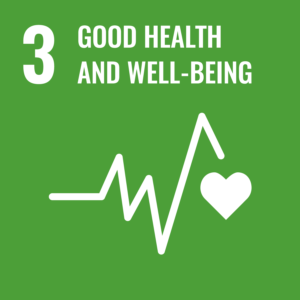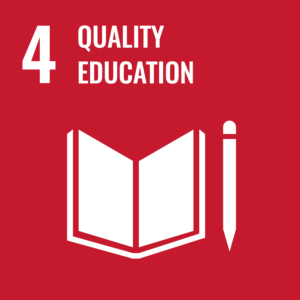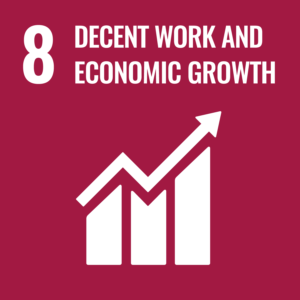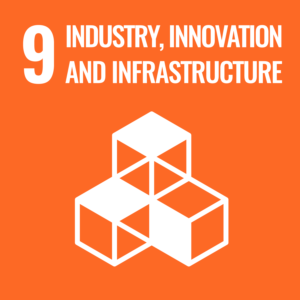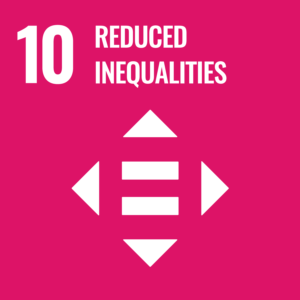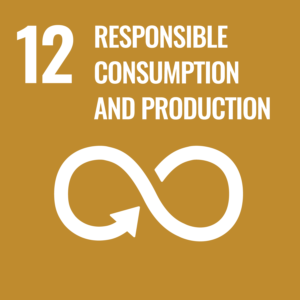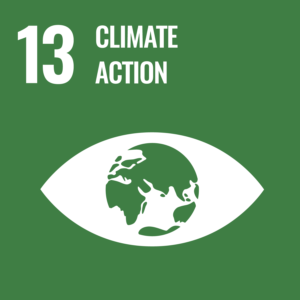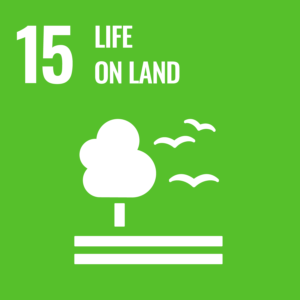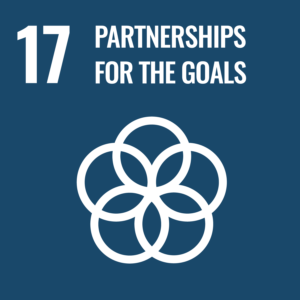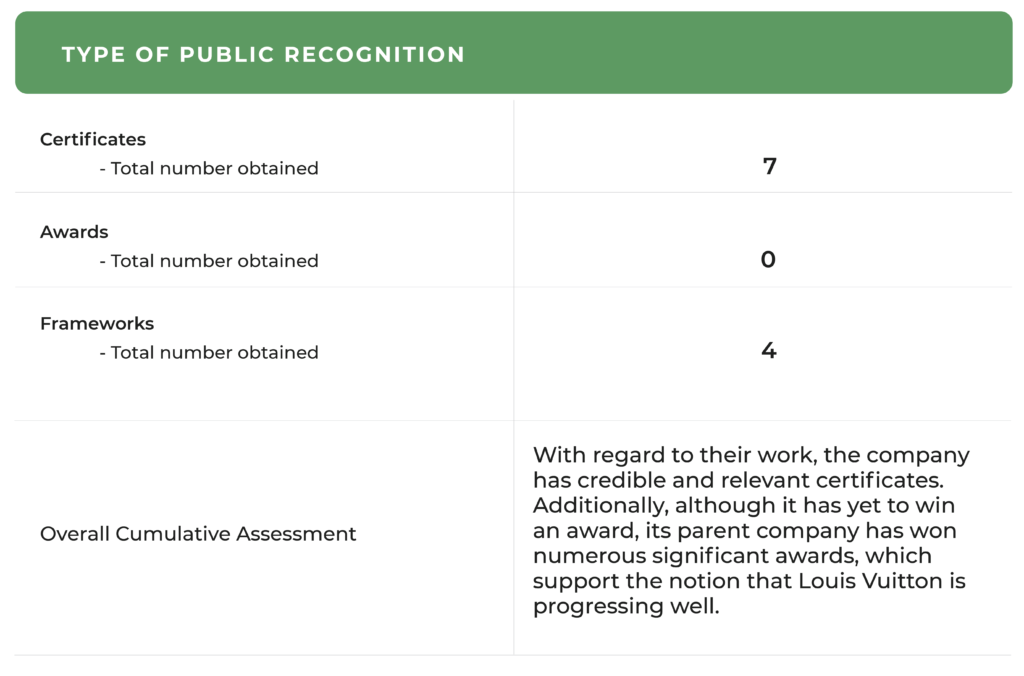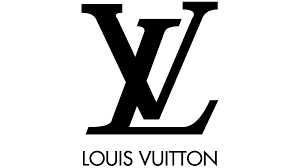
RATING

Neutral
SECTOR
Luxury Goods
Chief Sustainability Officer
Stock Exchange and Ticker
EPA: MC (LVMH)
Website
Contact
T: N/A
E.mail: N/A
Listing
- Louis Vuitton
- #30 The Halo 100 (2022)
- LVMH
- #181 World’s Best Employers (2022)
- #184 Best Employers for Women (2022)
- #61 Global 2000 (2022)
- #481 Best Employers for Diversity (2022)
- #284 America’s Best Large Employers (2022)
- #274 America’s Best Employers (2021)
Awards
- The Euronext CAC 40 ESG index (LVMH)
- The Euronext Vigeo Eurozone 120 index (LVMH)
- LVMH was ranked in the TOP 5 by Moody’s ESG Solutions for the Luxury Goods & Cosmetics segment, with a rating of 67/100 (LVMH)
- FTSE Russell – a rating of 4.4/5 (LVMH)
- MSCI – “A” rating (LVMH)
- Sustainalytics – Lowest Risk with a rating of 12.4 (LVMH)
- Workforce Transparency Awards (LVMH)
- S&P Global Sustainability Award (LVMH)
- Axylia gave LVMH an A rating for its Score Carbone®
- LVMH was rated A- by the CDP
- LVMH ranked 3rd in a list of 604 companies analyzed by Open Corporation, with a score of 83/100
- The Global Child Forum awarded a score of 7.4/10 to the LVMH Group, categorizing it as an “Achiever” (LVMH)
- Universum France ranking (LVMH)
- Refinitiv Diversity & Inclusion Index (LVMH)
Revenue
€64, 215 M (LVMH)
Market Capitalisation
€331,95 M (LVMH)
Employees
175,647 (2021)
Content source
- Our Committed Journey | LOUIS VUITTON
- 2021 Social and Environmental Responsibility Report | LVMH
- https://www.statista.com/statistics/245852/total-revenue-of-the-lvmh-group-worldwide/
- LVMH Group: number of employees worldwide 2021 | Statista
- Louis Vuitton – Headquarters Locations, Products, Competitors, Financials, Employees
- https://www.forbes.com/companies/louis-vuitton/?sh=680c3c046dbe
- Gender Pay Gap Report | LV= Liverpool Victoria
Louis Vuitton Sustainability Report
Evaluation of Louis Vuitton
Louis Vuitton (part of multinational holding LVMH) is one of the world’s leading international fashion houses, selling clothes through its own boutiques or lease stores in high end shopping areas. The information was gathered from the parent company’s report and the company’s own website because the company does not have its own sustainability report. Although Louis Vuitton’s goals are clearly stated and in line with the standards it upholds, it can be said that it has made a little less progress than the parent company, even though the parent company has taken firm and quick steps in line with its goals.
The worst work of the company is still using animal skin, fur, and other parts of the animals for some products, even though it is working to reduce its greenhouse gas emissions, waste, and energy consumption. On the Internet, its merits are often praised. However, as some sources state, Louis Vuitton needs to become much more transparent to meet the expectations of a new generation of fashionistas and do much more to reduce its impact on people, the planet and animals.
Sustainability Scorecard
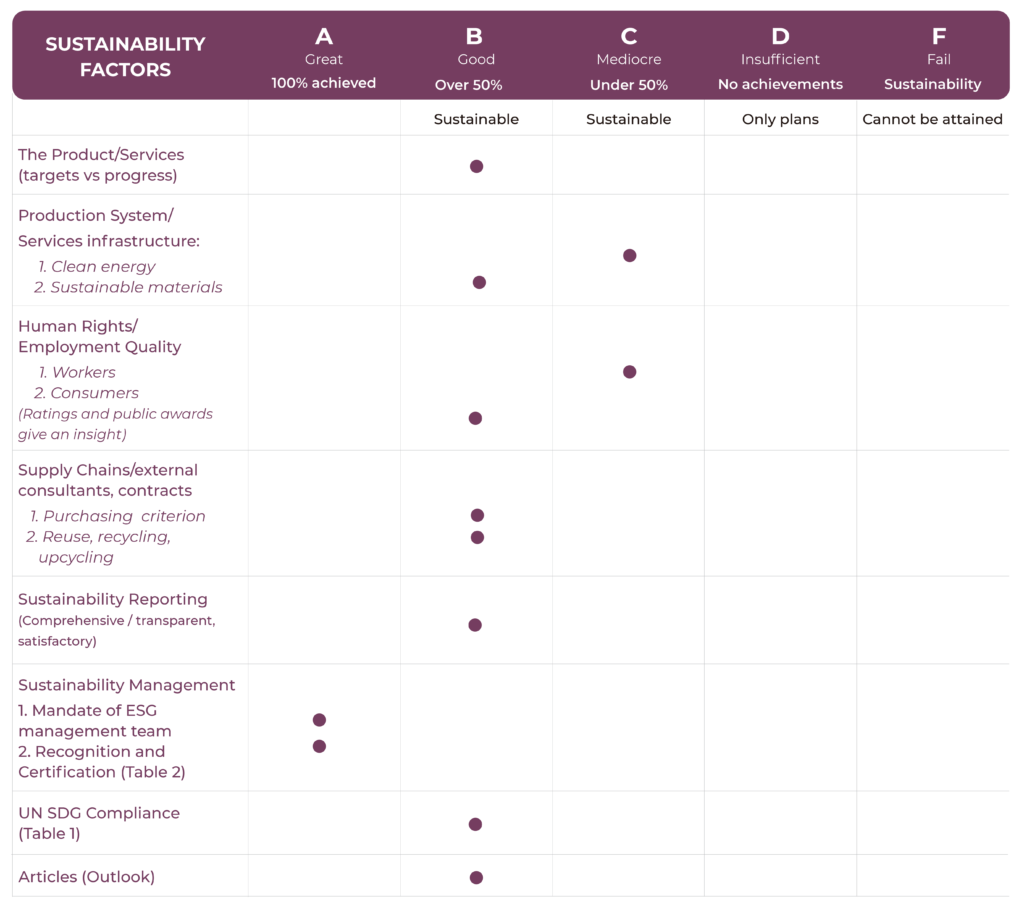
Louis Vuitton Company Activity
Founded in Paris in 1854, Louis Vuitton perpetuates the ambitious vision of its namesake. From his origins as a master trunk maker, manufacturing boxes used to pack both everyday objects as well as voluminous wardrobes, Louis Vuitton and his successors introduced numerous innovations including the advent of the flat-top trunk, lightweight canvas, signature patterns, and the tumbler lock. Today, Louis Vuitton’s legacy is expressed through its rigorous spirit of innovation, the boldness of its creations and an uncompromising demand for excellence.
Louis Vuitton Sustainability Activity - As per company declarations
At Louis Vuitton, we believe that sustainability is a journey that takes long term commitment and humility. The humility to pay as much attention to what we have already achieved, as to what remains to be done. A journey made possible by engaging everyone. A journey that requires all of us to question everything we do and how we do it, to constantly improve and go further. That’s the journey we are on since 1854
Certificate & Labels, Standards and Frameworks
- The United Nations Global Compact (LVMH)
- The Universal Declaration of Human Rights (LVMH)
- The OECD Guidelines for Multinational Enterprises (LVMH)
- Patrimoine Habitat (LVMH)
- SBTi
- HQE Exceptional certification
- Effinergie +
- BREEAM
- LEED
- Sustainable winegrowing certification (LVMH)
- LWG certification of tanneries for bovine and ovine leather (LVMH)
- LWG certification of tanneries for crocodile skin leather (LVMH)
- Certified cotton
- Certified paper, cardboard and wood (LVMH)
- Certified sheep’s wool (merino and other species) and cashmere
- Certification for all crocodile farms supplying the Group’s tannery (LVMH)
- Diamonds: RJC COP certification (LVMH)
- ISO 14001
Louis Vuitton in the news: Press Reviews and Social Media
How Ethical Is Louis Vuitton? – Good On You
It should come as no surprise that luxury brand Louis Vuitton is “Not Good Enough” for the environment. The brand receives a “Not Good Enough” rating for how it treats supply-chain workers. The final stage of production is carried out in nations with a medium risk of forced labor. It adds even more to the destructive fashion industry, which prioritizes exclusivity over sustainability at every turn, like other upscale fashion houses. Unfortunately, the company’s supply chain suppliers and workers are not adequately protected against the effects of COVID-19 by its policies or safeguards.
The fashion industry depends on its workforce, so Louis Vuitton must do better to ensure everyone has safe and equitable working conditions. Despite having a basic formal policy to protect animal welfare, Louis Vuitton is rated “Very Poor” for the treatment of animals due to its use of fur, down, leather, wool, exotic animal skin, and exotic animal hair. With so many advances in vegan fabric, using them in such a way is no longer necessary. Such a flagrant disregard for the welfare of the sentient beings we share the planet with is out of date. Customers have a right to know who made their clothes and how their wardrobe decisions affect the environment and animals.
How Louis Vuitton Is Building a Sustainable Future, Even If Its Customers Aren’t Ready
According to Louis Vuitton, it will accomplish all of its sustainability objectives by 2025. The upscale brand claims that 93 percent of the materials it uses for events and windows are already recycled or reused. It belongs to the LVMH group, which earned more than $59 billion in revenue in 2019. When it comes to its production runs, Louis Vuitton is becoming more cautious. It revealed its first vegan leather sneakers earlier this year, which were made with 90% recycled and bio-based materials.
Additionally, the brand promotes repairs. According to Louis Vuitton, the number of repair requests has increased by 20% since 2016. The UN Fashion Charter recently welcomed Louis Vuitton. According to group environment development deputy director Alexandre Capelli, efforts across brands are also being investigated. As part of its transition, LVMH is also embracing regenerative agriculture. Sustainability and the luxury lifestyle have always been intertwined.
The new home of Louis Vuitton’s Our Committed Journey, which aims to reduce its carbon footprint and improve its environmental performance by embracing circular creativity on all fronts, is Atelier Oratoire. In its store designs, the company has incorporated approved eco-practices like LED lighting and renewable energy. LVMH outfitted several attendees at the Met Gala in New York City in vintage archival pieces in May, promoting rewear (a simple circular practice) on the red carpet. It will only use renewable energy in its production and logistics facilities by 2025. The opening of two more bioclimatic workshops is scheduled for France.
Louis Vuitton Handbags and the Future of Sustainable Fashion
Only oil is more accountable for 10% of the world’s carbon emissions than the apparel sector. With 80 billion new pieces of clothing produced annually, most of which end up in landfills, fast fashion is having a greater-than-ever negative impact on our already vulnerable ecosystem. By embracing eco-design, Louis Vuitton is redefining what constitutes fashion. The handbags that represent the company are made of Econyl Regenerated Nylon. Over the past five years, there has reportedly been a 20% increase in the need for repairs, with leather straps being the most frequently fixed component.
Highlights from Louis Vuitton Sustainability Report
Achievements
- Expanding raw materials certification progress
- The Louis Vuitton Foundation earned HQE Exceptional certification
Weaknesses and Setbacks
- No report published, just the parent company has a report
- Use of fur, down, leather, wool, exotic animal skin, and exotic animal hair
Targets vs Progress Reported
| Target | Results reported |
|---|---|
| Packaging: zero virgin fossil-based plastic by 2026 (LVMH) | 6% reduction (8,632 metric tons) in the amount of virgin fossil-based plastic used in customer packaging (LVMH) |
| 100% of strategic supply chains will integrate dedicated traceability systems by 2030 (LVMH) | 4,000 products carry their own customer information system (LVMH) |
| 100 % of strategic raw materials certified to standards guaranteeing the preservation of ecosystems and water resources by 2026 (LVMH) | - 41% of recycled raw materials used in plastic and glass packaging (LVMH) - Certification of strategic supply chains (LVMH) : Cotton: 61% (51% in 2020) Leather: 81% (74% in 2020) Diamond: 99.9% (99% in 2020) LVMH vineyards: 92% (no change) |
| 5 million hectares (50,000 sq. km) of flora and fauna habitat restored and/or preserved by 2030 (LVMH) | 657,000 hectares of flora and fauna habitat restored and/or preserved (LVMH) |
| Reducing direct carbon footprint by 55% by 2030 | 6% reduction in GHG emissions generated by energy consumption (2019 baseline) |
| 100% renewable or low-carbon energy at sites and stores by 2026 (LVMH) | 39% of renewable energy in the Group energy mix (LVMH) |
| 100% Led lighting in their stores by 2030 | 57% of stores are lit entirely by LED lighting (LVMH) |
| Reduce greenhouse gases emissions from energy consumption by 55% by 2030 | Reduction in greenhouse gases emissions from energy consumption by 13% between 2019 and 2021 (on a comparable basis) |


